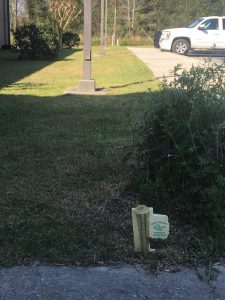In March, most producers are intently watching the weather for soil temperature and frost warnings, especially if they grow vegetables. Last week we had two days with some frost on the ground. grass was greening up and warm season weeds were starting to emerge.
This morning there was a moderate frost on the ground. According to the weather station, soil temps were around 50 this week. As you watch the weather I would like to provide you with some tools that may help you understand long term weather patterns.
- UGA WEATHER STATION: UGA has an online weather site that you can access weather stations all across Georgia. There is a tool on this site that will allow you to calculate growing degree days for any given period of time. This is especially helpful with peanut maturity. (If you don’t agree with my magic board, then digging on accumulated growing degrees is much more accurate than going on a set number for that variety like 140 days for Ga-06G, but the board is still the best.) this weather site will also give you soil temps at multiple depths, wind speed, and much more. For this site, click on the link: https://www.georgiaweather.net/
- UGA CLIMATOLOGIST BLOG: Pam Knox is the UGA climatologist out of Athens. She is extremely knowledgeable and I find her information to be extremely helpful, especially if you are in to weather patterns and long term predictions. If you are interested in how China prevented rain clouds from forming over the 2008 Olympics, or how Arab countries make rain clouds produce more precipitation, then subscribe to her blog here (Side note, this will not make you an expert but it will make you feel like an expert): https://site.extension.uga.edu/climate/
- SOUTHEAST WATERSHED PROJECT: There is a huge watershed project that has over 26 weather stations in Turner County. This is absolutely perfect because that means most of you have an online accessible weather station within just a few miles of your farm. You can access instant rainfall on or very near your farm online. Very detailed information including wind speed and soil temperature is available. View this website at the following link: https://www.tifton.uga.edu/sewrl/radio/lrdata.htm
- DROUGHT MONITOR: To see official reports of drought across the United States go to the drought monitor website: https://droughtmonitor.unl.edu/
- DROUGHT REPORTING: The 2016 growing season was very dry. Many people were concerned that we were not going to trigger a payment on pastures through FSA. The payment was determined by the official Drought Monitor Report. Some of this reporting is determined by personal observations recorded on several known websites. I do not know of anyone that is reporting on a regular basis on the correct websites. I feel that it may be a good idea if 3-5 to people in the county consistently report. This way data received from our county looks legit. If you are interested in consistently reporting, do so on the following websites. The drought reporter website is directly related to the drought monitor. The Cocorahs website is a private site that the drought monitor takes into account. Both website links are here: https://droughtreporter.unl.edu/map/ https://www.cocorahs.org/